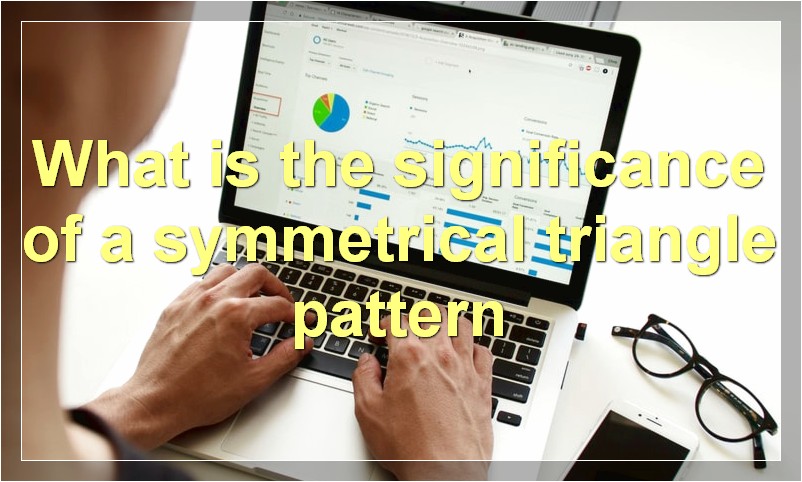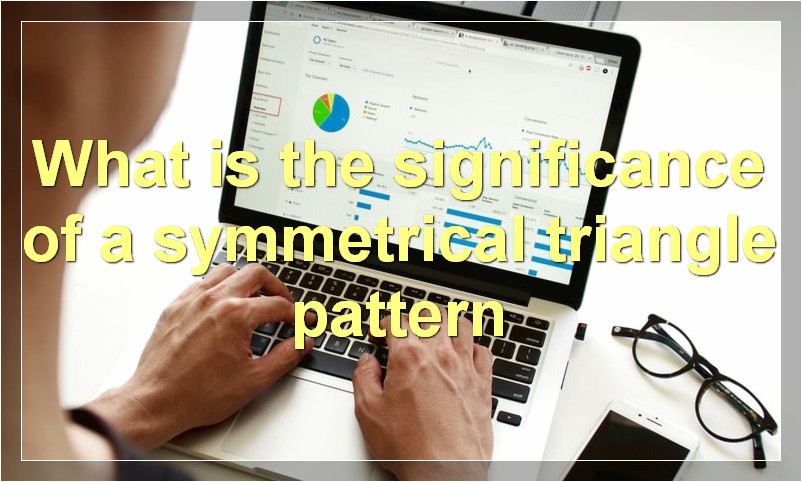If you’re looking to trade a symmetrical triangle pattern, there are a few things you need to know. First, it’s important to identify the trend leading up to the formation of the pattern. Second, you need to be aware of the potential breakout points. And third, you need to have a plan for managing your trade once the breakout occurs. In this article, we’ll take a closer look at each of these three factors and show you how to trade a symmetrical triangle pattern.
What is the significance of a symmetrical triangle pattern

When it comes to technical analysis, there are a few key things that you always want to keep an eye out for. One of these is called a “symmetrical triangle pattern.” This is a very important pattern to look for, because it can give you a lot of insight into what the market is doing.
Essentially, a symmetrical triangle pattern is created when the price action of a security creates a series of lower highs and higher lows. This usually happens over a period of time, and it forms a triangle shape on a chart. The reason why this pattern is so important is because it shows that the market is consolidating. This means that the buyers and sellers are essentially in a standoff, and no one is sure which way the market is going to go.
What you want to look for when you see a symmetrical triangle pattern is a breakout. This is when the price finally breaks out of the triangle and heads in one direction or the other. If you can identify a breakout, then you can often make some profitable trades.
So, to sum it up, the significance of a symmetrical triangle pattern is that it shows that the market is consolidating and that a breakout is likely to occur. If you can identify these patterns, then you can often make some money in the markets.
How is a symmetrical triangle pattern formed
A symmetrical triangle pattern is a chart pattern that is created when the price of a security converges towards an apex, forming two sides of a triangle. The two sides are created by a series of higher highs and lower lows, or vice versa. The triangle is considered symmetrical because the left and right sides are mirror images of each other.
What is the trading strategy associated with a symmetrical triangle pattern
A symmetrical triangle is a chart pattern characterized by two converging trendlines that form a triangle. This pattern is considered a continuation pattern, which means that the price is expected to continue in the same direction after the pattern completes. There are three main types of trading strategies associated with a symmetrical triangle pattern: breakout, reversal, and consolidation.
The breakout strategy is the most common and involves taking a long or short position when the price breaks out above or below the trendlines. The reversal strategy is used when the price reverses at the completion of the pattern and takes a position in the opposite direction. The consolidation strategy is used when the price consolidates within the trendlines and no clear breakout or reversal occurs.
What are the potential risks and rewards associated with trading a symmetrical triangle pattern
When trading a symmetrical triangle pattern, there are potential risks and rewards associated with the pattern. The risks include the potential for a false breakout above or below the triangle, as well as the risk of a breakout in either direction that does not reach the target price. The rewards include the potential for a breakout in either direction that reaches the target price, as well as the potential for a false breakout that results in a quick profit.
How can I identify a symmetrical triangle pattern

A symmetrical triangle is a pattern that can be found in charts when prices are consolidating and trading within a tight range. The pattern is created when the highs and lows of the price action form two converging lines, creating a triangle shape on the chart. This pattern can be found in both bull and bear markets, and it is generally seen as a continuation pattern.
The key to identifying a symmetrical triangle is to look for two trendlines that are converging towards each other. These trendlines will form the sides of the triangle, and the point where they converge is called the apex. The symmetrical triangle is considered a continuation pattern because it usually forms during a period of consolidation, when the market is “chopping” around within a defined range.
Once the triangle has been identified, traders will watch for a breakout to occur. A breakout is when the price action breaks above or below one of the trendlines that make up the triangle. This move signals that the consolidation period is over and that prices are about to start moving in a new direction.
The direction of the breakout can be used to help identify which way the market is likely to move. If the price breaks out above the upper trendline, then it is likely that prices will continue to move higher. Conversely, if the price breaks out below the lower trendline, then it is likely that prices will continue to move lower.
The symmetrical triangle is a useful pattern for traders to be aware of because it can help them anticipate breakouts and identify potential trading opportunities.
What are the key characteristics of a symmetrical triangle pattern
There are three key characteristics of a symmetrical triangle pattern:
1) The sides of the triangle are of equal length.
2) The angles of the triangle are all equal.
3) The triangle is symmetrical about its center.
Is a symmetrical triangle pattern always bullish or bearish
The symmetrical triangle pattern can be either bullish or bearish, depending on the direction of the breakout. If the breakout is upward, then the pattern is bullish. If the breakout is downward, then the pattern is bearish.
What is the average duration of a symmetrical triangle pattern
A symmetrical triangle is a chart pattern that is created when the price action of a security forms two converging trendlines. These trendlines are created by connecting a series of lower highs and higher lows, and they typically converge at a point known as the apex. The symmetrical triangle is considered a neutral pattern, which means that it can be found in both uptrends and downtrends. The average duration of a symmetrical triangle pattern is about six weeks.
How does the size of a symmetrical triangle pattern affect its trading implications
The size of a symmetrical triangle pattern affects its trading implications in a few ways. First, the larger the triangle, the more reliable it is as a predictor of future price movement. Second, the bigger the triangle, the greater the potential price move that it indicates. Finally, large triangles tend to take longer to form than small ones, so they may be more useful for long-term traders.

